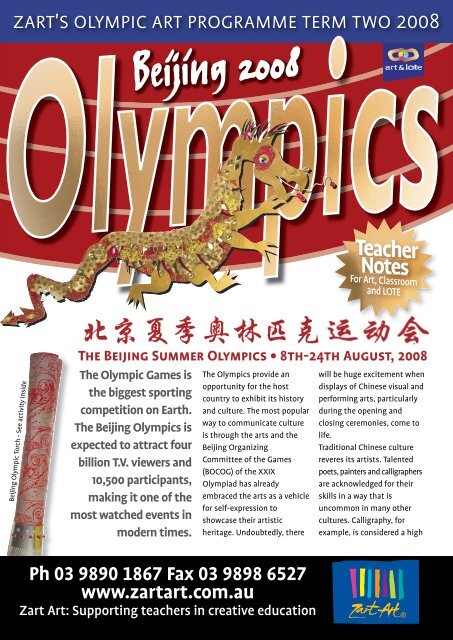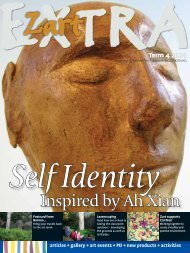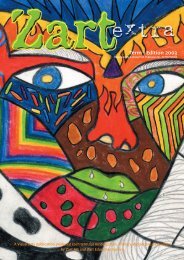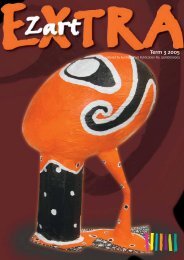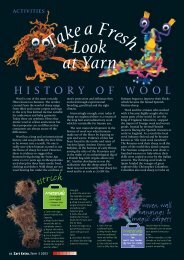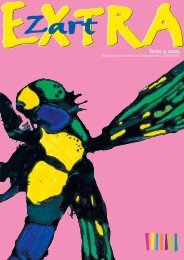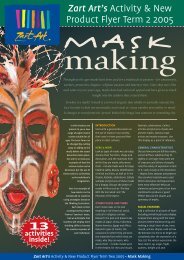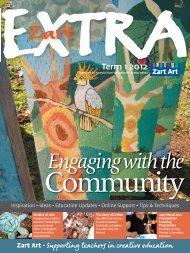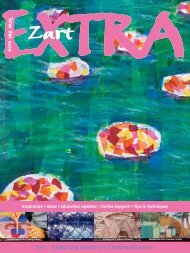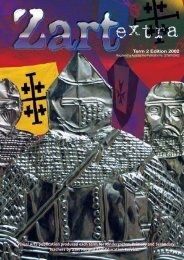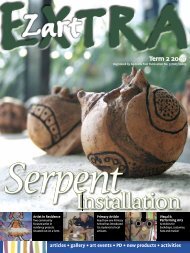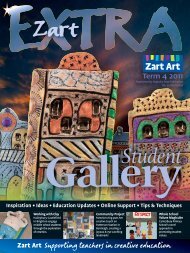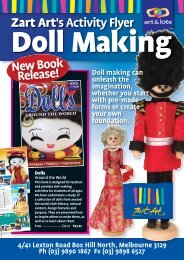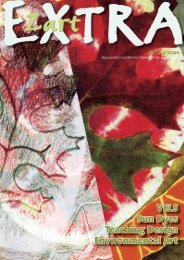Create successful ePaper yourself
Turn your PDF publications into a flip-book with our unique Google optimized e-Paper software.
zart's olympic art programme term two 2008Beijing 2008art eTeacherNotesFor <strong>Art</strong>, Classroomand LOTEBeijing <strong>Olympic</strong> Torch - See activity insideThe Beijing Summer <strong>Olympic</strong>s • 8th-24th August, 2008The <strong>Olympic</strong> <strong>Games</strong> isthe biggest sportingcompetition on Earth.The Beijing <strong>Olympic</strong>s isexpected to attract fourbillion T.V. viewers and10,500 participants,making it one of themost watched events inmodern times.The <strong>Olympic</strong>s provide anopportunity for the hostcountry to exhibit its historyand culture. The most popularway to communicate cultureis through the arts and theBeijing OrganizingCommittee of the <strong>Games</strong>(BOCOG) of the XXIXOlympiad has alreadyembraced the arts as a vehiclefor self-expression toshowcase their artisticheritage. Undoubtedly, therewill be huge excitement whendisplays of Chinese visual andperforming arts, particularlyduring the opening andclosing ceremonies, come tolife.Traditional Chinese culturereveres its artists. Talentedpoets, painters and calligraphersare acknowledged for theirskills in a way that isuncommon in many othercultures. Calligraphy, forexample, is considered a highPh 03 9890 1867 Fax 03 9898 6527www.zartart.com.au<strong>Zart</strong> <strong>Art</strong>: Supporting teachers in creative education1
art form in China and has a status that is equal topainting and poetry.Many of China’s top artists have contributed to thevisual design of the Beijing <strong>Olympic</strong>s. Already we cansee how these artists have drawn from their country’slong history of visual arts and married them withelements of modern design to produce somemagnificent works of art in the form of the relaytorch, mascots, pictographs and the medals for theforthcoming <strong>Olympic</strong>s.It is also important to note that Chinese symbolismplays a huge role in the visual design of the Beijing<strong>Olympic</strong>s. China has a long tradition of respectingnature; their love of nature is so profound that theyhave attached their sacred feelings to visualrepresentations of nature. For example, in Chineseculture, the pear tree symbolizes longevity because itlives for a very long time, the peony rose because of itrareness and exquisite beauty, represents wealth anddistinction and the magnolia flower is the emblem offeminine beauty and sweetness.The purpose of this booklet is not to copy what the<strong>Olympic</strong> artists and designers have created, but to drawupon their creative processes and historical sources toinspire students to create their own Chinese style ofvisual designs for the Beijing <strong>Olympic</strong>s.The Beijing<strong>Olympic</strong> ColourSystemYou will notice on theBOCOG’s official Website there is a sectioncalled “The ColorSystem” and below eachcolour is a series ofnumbers and letters.These letters willprobably mean nothingto most people but theyare actually aninternational colour codesystem. People whowork with colour such aspaper manufacturers,printers and textilemanufacturers, canachieve accuratedefinition of colourusing this code.The Chinese have alwaysappreciated vibrantcolours and thesymbolism of colour hasplayed an important rolein their history. TheBeijing <strong>Olympic</strong>Committee recognizesthe six traditional<strong>Olympic</strong> colours whichfeature in the fiveinterlocking ring symbolof the <strong>Olympic</strong>s,however, they havesuperimposed their ownethnic interpretation ofcolours to the Beijing<strong>Games</strong>. They have drawnfrom China’s greathistory and identifiedthe following colours/tones to represent theBeijing <strong>Olympic</strong>s. Thesecolours already featurein the visual imagery ofthe 2008 <strong>Olympic</strong>s. Seethe Beijing emblem,torch design, mascotsand pictographs. Whenstudents watch theBeijing <strong>Olympic</strong>s, askthem to take note of theuse of these colours inother aspects of the<strong>Games</strong> e.g. perhaps inthe uniforms,decorations andbackdrops.<strong>Olympic</strong> Ring ColoursThe five interlocking ring symbol of the <strong>Olympic</strong>smight be represented by decorating CardboardRings in the flag colours of five participatingcountries.The Blue-and-WhitePorcelain Bluepms 286The Glaze Yellowpms 186cWhite JadeChinese Redpms 186cThe Great Wall Greypms 443The ChineseScholar-Tree Greenpms 356c2
The Beijing <strong>Olympic</strong> Relay TorchAesthetic Design FeaturesShapeBased on a traditionalChinese scroll, it is sleekand elongated andslightly bent – a moderninterpretation of ahistorical Chinesesymbol .ColourRed and Silver(symbolizing a traditionaland a modern colour).The tone of red chosenwas the closest match tothe red doors of theForbidden City in Beijing.Line and PatternPattern of a circularswirling cloud motif.TextureThe clouds are embossedand the red lacquer finishcaptures the look of theHan Dynasty lacqueredboxes.The torch relay heralds in the <strong>Olympic</strong> <strong>Games</strong> everyfour years. The world will watch as the torch bearerscarry the torch from Olympia through 20 selectedcountries on route to the host city. The human chainthat carries the torch creates an interesting chain ofstories themselves. The route of the Beijing <strong>Olympic</strong>Torch is anticipated to cover the ancient Silk Road (thefirst link between China and the rest of the world) andMount Everest as well as 113 Chinese cities.The design team sourced traditional cloud patternsfrom ancient artefacts such as furniture, architecture,drawings, pots, vases, lacquer wear, stories andbrocade fabrics. They used line work to simplify andmodernize the chosen cloud shape. Once the desiredshape – a spiral cloud – was achieved, it was thenmade into a pattern repeat. This stylized cloud patterncovers the top half of the torch. Without doubt, the<strong>Olympic</strong> torch achieves a marriage between traditionalart and modern design.<strong>Olympic</strong> RelayTorchMaterialsCover Paper 51 x 76 cmPrinting FoamLiquitemp Paint GoldUni Signo Broad Gel PenWhiteMirror Board SilverFabric Netting SilverJug BeadsSequins in a Jar HologramArbee Craft GlueFoam Roller 85 mmUse a pen or pencil to draw apattern on to a piece of PrintingFoam that might represent acloud formation. Swirling,spiraling lines that cover thepiece of Printing Foam.Use a Foam Roller to ink upthe Printing Foam with goldpaint and press the designdown on to a sheet of CoverPaper. Repeat the print untilone side of a large sheet ofpaper is covered in the goldprint. Set aside to dry.Use a white pen toaccentuate the lines the printhas created on the colouredpaper.Roll the large sheetof printed paper into ascroll with the printfacing outwards. Stapleinside the roll to securethe scroll form.Use a sheet of silverMirror Board to wrap aroundone end of the rolled scroll andstaple the end of it to securethe wrapped board to thescroll.Wrap a piece of FabricNetting around the MirrorBoard to cover all but the topof the board, which may bedecorated with beads andsequins. Use glue to secure theFabric Netting to the torch.E DREAMERSteps®ExperimentUse other forms of printing such asmonoprinting to create a cloudpattern on coloured paper. Roll bandsof coloured paint on to a sheet ofacetate and use a Cotton Bud or fingerto draw a design into the wet paint.Place a sheet of coloured paper overthe wet design and press with thepalm of your hand. Peel away thepaper to reveal the print.DREAMER Steps® is a strategy forteaching. Please refer to page 16 formore information.s designed by <strong>Zart</strong> <strong>Art</strong>e©2008 <strong>Activity</strong> and not3
The Beijing <strong>Olympic</strong>EmblemThe Beijing <strong>Olympic</strong> emblem,named “Chinese Seal – DancingBeijing”, is a lively white dancingfigure on a vivid red background.Everything about the image isculturally Chinese. BOCOG’sdesign brief was to link China’ssports, culture and history withthe <strong>Olympic</strong> <strong>Games</strong>. Although overtwo thousand art works weresubmitted none captured the spiritof a Chinese <strong>Olympic</strong>s. So a groupof China’s top artists anddesigners were then selected towork on the task. A man practisingTaiji shadow boxing was theinspiration for the original sketchof the dancing figure produced byfamous Chinese designer, ChenShaohua. This was modified byartist Han Meilin who used acalligraphy brush to achieve thefinal result: a combination of aChinese seal, the art of calligraphyand sport.Behind the simple lines of thedancing figure emblem is a storyrich in cultural heritage. The finalfigure design is based on theChinese character Jing whichstands for the name of the hostcity “Beijing”. The figure has beendrawn using traditional Chinesecalligraphy; its graceful lines are infree-style strokes. Its open armsare welcoming and an invitation tothe rest of the world to join in theevent.The overall shape and style of theemblem is that of a Chinese sealcarving that has been engraved i.e.a Chinese name stamp. A seal is asymbol of commitment. The figurehas been carved out of stone andprinted on white paper.Below the vibrant dancing figureof the emblem is “Beijing 2008” inblack, so the overall effect of theemblem is striking and bold in red,white and black. Below the“Beijing 2008” is the fivetraditional coloured <strong>Olympic</strong> rings.Their presence on the emblemunites China with the <strong>Olympic</strong><strong>Games</strong> and the five continents therings represent. Refer to BOCOG'sofficial website.Chinese SealMaterialsPoly Drum KitPrinting FoamChromacryl PaintPaper MagiclayOcaldo BlocksFlorist Wire RainbowShimmer Glass PaintCreative Bead Box AssortedUni Signo Broad Metallic Gel PenUni Signo Broad Gel Pen WhitePaint a Poly Drum in a bright ShimmerPaint and set aside to dry.Model an item that is special to yourcharacter from Paper Magiclay that will siton top of the decorated Poly Drum.Paint and decorate the model withbeads and wire.Cut a disc of Printing Foam the samecircumference as the bottom of a PolyDrum.Use a pen or pencil to draw the designof your personal seal on to the PrintingFoam disc.Decorate around the painted Poly Drumwith Gel pens.Glue the Printing Foam disc with the4PolyDrum Kitdrawn design facing outwards on to oneend of the decorated Poly Drum.Glue a gold plastic disc to the oppositeend of the Poly Drum and glue on themodelled piece of Magiclay.Create a stamp pad with a sponge andpaint and use the seal to stamp print yourartwork or other projects with yourhandmade personal seal.DDREAMER Steps®DiscussionDiscuss the things that are important to thestudents and get them to write down the one thingthey believe would best represent them. E.g. Lealoves Rainbow Lorikeets, Jake loves frogs and Billloves football. Make up a chart of symbols that willbecome the personal seal for each student. Somemay overlap so discuss ways of making themdifferent. When the seals are created, print the sealsnext to the names to become their personal Chinesename stamps.DREAMER Steps® is a strategy for teaching. Pleaserefer to page 16 for more information.s designed by <strong>Zart</strong> <strong>Art</strong>e©2008 <strong>Activity</strong> and not
es designed by <strong>Zart</strong> <strong>Art</strong> ©2008 <strong>Activity</strong> and notPictogramsPictograms are one of the oldestforms of non-verbalcommunication. The word‘pictogram’ comes from pictomeaning ‘picture’ and grammeaning ‘message’. Pictograms aretherefore visual images – symbols,icons - that serve as points ofreference and help overcomelanguage barriers. They arerecognizable and easy to use andare important for identifying asport or directing people tovarious venues. They are also usedin the international broadcasting,imaging and marketing of the<strong>Olympic</strong> <strong>Games</strong>.The 35 pictograms designed for theBeijing <strong>Olympic</strong>s, called “Beauty ofSeal Characters”, depict the 35sports on offer and draw fromChina’s rich cultural roots. Thedesign was a joint venturebetween the China’s CentralAcademy of Fine <strong>Art</strong>s and theAcademy of <strong>Art</strong> and Design. Thepictograms have been createdusing black calligraphic strokes ona stark white background which isin keeping with traditional Chinesecalligraphy and rubbings,representing the mostrecognizable movement of eachsport. For example, the pictogramfor soccer shows a line figureabout to kick a ball. The designuses the basic form of theemblem’s “dancing figure” toshow 35 people in action. Thefigures are fun and drawn ingraceful lines that suggestmovement.<strong>Olympic</strong> PictogramsMaterialsCalligraphy Pens 3’sCartridge Paper A4<strong>Zart</strong> Paper MixPaper MagiclayBalloonsJo Sonja Paint CopperJo Sonja Paint Rich GoldMetallic Tissue PaperEC Indian InkChinese BrushesCraft Aluminium Wire GoldBeading Wire GoldCreative Bead Box Gold & Silver MixHot Melt Glue GunPVAShimmer Glass PaintBlow up a balloon to the intended sizeof the bowl to be made.Mix Paper Mix in an ice-cream containerwith water, to a sloppy dough mixture.Place the balloon, knot side down into amargarine container and apply the wetPaper Mix over the balloon. Work from thetop of the balloon and pat the mixturedown and around the balloon. When theshape is completely covered withapproximately 1 cm thickness of mixture,set aside to dry.Remove the balloon and paint theinside and outside of the bowl with JoSonja Copper paint.Look on the Internet at the Pictogramsfor past <strong>Olympic</strong> <strong>Games</strong> and those createdfor the Beijing <strong>Olympic</strong>s. On a sheet ofpaper, use Calligraphy Pens to create aseries of pictograms that are simple butrepresent different sports.Choose a number of your pictogramsand use a brush and ink to paint these onto a sheet of gold Tissue Paper.Cut the Tissue Paper designs into smallsquares or rectangles and glue themaround the painted bowl as decoration.Create handles and a stand for the bowlusing Craft Aluminium Wire, Beading Wireand small beads. Glue these on to thebowl with a Hot Melt Glue Gun.EDREAMER Steps®ExperimentUse Paper Magiclay to create a simple bowl shapeand decorate the bowl with pictograms. Try makinga tiny bowl with three legs, a bowl with finer wiredecoration and use other media to decorate a bowlto resemble ancient Chinese vessels.DREAMER Steps® is a strategy for teaching. Pleaserefer to page 16 for more information.e©2008 <strong>Activity</strong> and nots designed by <strong>Zart</strong> <strong>Art</strong>5
The Beijing Mascots: Five “Fuwa”Cardboard Puppet DollsShimmer PaintMetallic Ripple Paper A4Defraction Paper A4 AssortedSequin LeavesEyeball Stickers LargeSequins in a Jar DiamondsGold and Silver MixSequins LargeMetallic Wire CordCraft Aluminium WireFeathersPartridge FeathersColour Weave FabricLow Melt Glue GunCover Paper A4Pattern Paper FishJewelsCardboardPuppet DollsRetro Pop Paper A4Paper MagiclayAlumininium Embossing Foil Goldand GreenSkeleton LeavesPom Poms 18 mm BlackColour Diffusing LeavesFood DyePaint each section of a CardboardPuppet Doll in the chosen colour andwhen dry use the Paper Fasteners to jointhe doll together. Two of the cardboardstrips are fastened to the doll at the kneeand elbow joints to enable the doll tomove. The third cardboard strip is glued ortaped to the back of the doll’s body.Decorate the doll with the colour of themascot chosen and use collage materialsto dress the mascot to represent itscharacter. E.g. red represents fire as theelement of nature, whereas green is aswallow, blue is a fish, black is a pandaand yellow is an antelope.RDREAMER Steps®ResponseDid the mascots made in class, capture the natureof the five Fuwa? What inspired the student tochoose a particular colour and what does theirmascot represent? Did they choose their favouritecolour, and/or animal on which to base their ownFuwa?DREAMER Steps® is a strategy for teaching. Pleaserefer to page 16 for more information.e©2008 <strong>Activity</strong> and nots designed by <strong>Zart</strong> <strong>Art</strong>The Beijing <strong>Olympic</strong> MedalsThe medal designed for the Beijing <strong>Olympic</strong>s is thefirst <strong>Olympic</strong> medal not to be totally made of metal –it is actually made of a combination of metal andjade. It is 7 cm in diameter and 6 mm thick. Theobserved side of the medal is completely metal (gold,silver or bronze) and has the traditional IOC(International <strong>Olympic</strong> Committee) image of thewinged goddess of victory, Nike and the Panathinaikosarena (this image featured repeatedly in the Athens<strong>Olympic</strong>s) engraved on the surface.The inspiration for the medals came from an ancientChinese jade bi. This is a pendant (still) worn aroundthe neck and is usually made of white, jade or greenand with a hole in the centre. In ancient China this7
shape symbolized a circle withoutbeginning or end, like the sun and/or sky – all signs of eternal life.Jade bi were initially smooth butwere later decorated with carvedsymbols. They were worn for luckor used in rituals such as infunerals where they covered theopenings of the body e.g. thenose. The reverse side of the medalfeatures the jade bi. The goldmedal features a white jade bi, thesilver medal features a light greenbi and the bronze medal features adark green jade bi. In the centre isthe Beijing <strong>Olympic</strong> emblemengraved in metal. The medal hookis in the shape of a swirling dragonand was inspired by an ancientceremonial jade huang piece thatwas decorated with a dragonpattern and a reed mat pattern.The ribbon holding the medal is inlucky and festive Chinese red andfeatures a woven cloud pattern(see <strong>Olympic</strong> Torch graphics) andthe five interlocking <strong>Olympic</strong>Rings. The medal is housed in atraditional Chinese lacquered boxwhich has slightly curved sides – asymbol of heaven and earth - andthe certificate is made of thin silkand rice paper, making it a fusionof a traditional paper-makingtechnique with modern printing.<strong>Olympic</strong> MedalsCardboard BaublesCardboard BaublesPaper MagiclaySilkee PaperAlumininium Embossing Foil Silver,Gold and CopperSatin Ribbon 3 mm RedPre-Cut Mounts A6 BlackDouble Sided Tape 18 mmUni Signo Broad Gel Pen WhiteClear Adhesive Tape 18 mmSupertacDefraction Paper SilverRubbing Plate Large TextureUHU Glue StickOcaldo BlocksCreate an embossed Paper Magiclay discby rolling a small ball of Magiclay over atextured surface and cutting out a roundshape, approximately 55 mm.Push a 50 cent coin into the middle ofthe shape to create a slight indentation.When the disc is dry, paint with a chosencolour using Ocaldo Blocks.Cut a disc the size of a 50 cent coin fromEmbossing Foil and place it on a wad ofnewspaper.Draw directly on to the Embossing Foilwith a pen or pencil, a symbol to representthe chosen <strong>Olympic</strong> event the medal is for.Cover a Cardboard Bauble withDefraction Paper and glue on the Magiclaydisc with the embossed disc glued in thecentre of it.Thread a length of Satin Ribbon throughthe hole at the top of the decoratedbauble.If all three medals have been made byone or a group of students they may like toexhibit them in Pre-Cut Mountssurrounded by words of encouragement orwords that describe what the <strong>Olympic</strong><strong>Games</strong> means to them. Use a white orsilver pen on the black mount to write thewords around the mount. Tape Silkee Paperto each mount with the medal hangingdown from the top of the frame. Join threemounts together with clear tape to form aconcertina display.RDREAMER Steps®ResponseStudents discuss the possibility of using differentmedia to create medals for the <strong>Olympic</strong> <strong>Games</strong> inLondon 2012. How will they depict somethingsymbolic of England? The inspiration for the Beijingmedals came from an ancient Chinese jade bi.DREAMER Steps® is a strategy for teaching. Pleaserefer to page 16 for more information.e©2008 <strong>Activity</strong> and nots designed by <strong>Zart</strong> <strong>Art</strong>8
Beijing <strong>Olympic</strong>ArchitectureTwo new buildings stand outfor their architecturalbrilliance and inventiveness -the Beijing <strong>Olympic</strong> stadiumwhich is affectionately calledthe “Bird’s Nest” and theNational Swimming centrewhich has been dubbed the“Bubble Building”.Refer to the official BOCOG'swebsite for images of thesetwo stadiums:Cardboard Weaving Base Template<strong>Olympic</strong> StadiumsMaterialsCardboard Weaving BaseMatch Sticks ColouredStrawsSupertacLow Melt Glue GunSpray Paint FluorescentSpray Paint Gold and SilverGallery Oil Pastels MetallicGallery Oil Pastels FluorescentUse Spray Paint or Oil Pastels tocompletely cover both sides of a CardboardWeaving Base, including the surroundingcardboard.Caution must be taken if using SprayPaint. Create a spray booth out of an oldcardboard carton and only spray outside theroom, inside the booth. Use gloves toprotect the hands from paint.Separate the Cardboard Weaving Basefrom the surrounding card and fold upalternate flaps around the base.Use the flaps facing down to glue thebase to the surrounding template card.Glue different lengths of plastic Straws tothe flaps and use these to randomly addStraws of varying lengths and colours tocreate a futuristic building similar to theNational Stadium or Bird’s Nest as it isreferred to as.Keep on adding Straws until you reachthe height and design of the building.Glue coloured Match Sticks on andaround the stadium to add anotherdimension to it that complements the basicstructure of overlapping straws.EDREAMER Steps®ExperimentExperiment with a variety of construction media, suchas Wooden Spills, Satay Sticks, Popsticks, Construct aStick, Fairy Floss Sticks and Match Sticks to create astadium of the 21st century.DREAMER Steps® is a strategy for teaching. Please referto page 16 for more information.e©2008 <strong>Activity</strong> and nots designed by <strong>Zart</strong> <strong>Art</strong>9
Lucky CharmsMaterialsWooden Pen DollOriental Decorative PaperCreative Metallic BraidPellicano CottonFolley Bells 10 mm GoldPlasticine BlackSupertacPosca Marker7.5 cm Cardboard ConeWooden Bead 30 mm and 25 mmWooden Bead 14 x 25 mmCreative Bead Box AssortedJug BeadsPrinting FoamMountboard Tags BlackSilkee PaperRice PaperLow Melt Glue GunLiquitemp Metallic Paint – GoldWooden Pen DollCharmsUse a marker on thepen head to draw on thehair and facial featuresof the doll.Add hair withPlasticine or PellicanoCotton and CreativeMetallic Braid.Wrap and glue a pieceof Oriental DecorativePaper around the bodyof the pen.Use Pellicano Cottonor Creative MetallicBraid to thread and tiebeads and bells on todecorate the charm.Cone CharmsCover a Cardboard Cone withOriental Decorative Paper. Gluesmall bows of Creative MetallicBraid down the front of thecone.Use a marker to draw thehair and facial features of a dollon to a round 30 mm WoodenBead.Fold a long length ofCreative Metallic Braid in halfand knot a loop at the topbefore threading the lengthdown through the bead andcone. Glue the length insidethe bead head at the knotso that the loop remains atthe top of the head.Glue the bead head to thetop of the decorated cone.Thread and tie on beadsalong the braid below the coneand tie on a tassel of braid tothe end of this length. Tasselsare made by cutting CreativeMetallic Braid in equal lengths,folding the numerous lengthsin half and tying braid aroundthe fold at the mid point tosecure. A length of Braid isthen wound around thefolded braid just downfrom the top to form atassel.knotBead CharmsCover an oval WoodenBead with Rice Paper.Use a marker to draw hairand facial features on to around 25 mm Wooden Bead.Thread a length of PellicanoCotton and Creative MetallicBraid through the two beadsand glue the two beadstogether.Tie a loop in the top of eachthread and glue the knots ofthese two loops inside the beadhead.Tie on an assortment ofbeads and bells to the twolengths of thread below the ovalbead.RDREAMER Steps®ResearchLucky Emblems or Charms can take on anyform and may be man-made or fromnature. Use books or the Internet todiscover the folklore behind such luckycharms as a rabbit’s foot, a horse shoe,four leaf clovers etc.See our website for Hama Bead and PolyEgg charms. DREAMER Steps® is a strategy for teaching.Please refer to page 16 for moreinformation.Wooden PenDolls designed by <strong>Zart</strong> <strong>Art</strong>e©2008 <strong>Activity</strong> and notTag CharmsDraw a design that may beyour lucky emblem, on to apiece of Printing Foam. Thedesign needs to be slightlysmaller than a Mountboard Tag.Use gold paint to roll on to thedrawn design and print the imageon to a piece of Silkee Paper. Setaside to dry.Cover a Mountboard Tag withOriental Decorative Paper.Tie beads and bells along twolengths of Creative Metallic Braid.Glue a loop of Creative MetallicBraid to one end of the tag andglue the beaded lengths of braid tothe opposite end.Create a tassel with Creative MetallicBraid and glue this on to the tag.Glue the printed Silkee Paper designon to the covered Tag, covering the endsof braid where they are glued to the tag.10
CardboardDoll Fold-upCardboard DollFriendship BookMaterialsCardboard Doll Fold-upJoggle Eyes 5 mmJoggle Eyes 8 mmFelt Brown or BlackOriental Decorative PaperBudget Fineline PenGiotto Turbo Maxi MarkersPVASatin Ribbon 3 mm RedPaper Stripping 50 mm RedAcetate 0.5 mm thick A4One Hole PunchEach student decorates with collage ormarkers, three of the cardboard dolls torepresent themselves. The first doll in thesequence is dressed in the student’sfavourite clothing. The second dollillustrates the student’s favourite colour.The third doll illustrates the student’sbirthday or something quite special aboutthem.Felt or other media may be used for hair,Joggle Eyes stuck on to each face and facialfeatures drawn in with a fineline pen.The front and back cover of theFriendship Book may be made up of fourdolls decorated in different coloursrepresenting countries attending the<strong>Games</strong>.Make a banner using Paper Strippingthat includes the motto of these <strong>Games</strong> –One World One Dream.Attach the Paper Stripping to a thin stripof Acetate with a hole punched into eitherend.Punch a hole into the arm of the firstdoll in each sequence and join the sets bythreading a length of Satin Ribbon througheach set, starting with the cover andDs designed by <strong>Zart</strong> <strong>Art</strong>finishing with a set facing outwards.Tie the banner on to the front cover ofthe Friendship Book and stand the book upoutside the classroom for all to see.DREAMER Steps®DiscussionThe motto of the Beijing <strong>Olympic</strong>s of One World OneDream will have different interpretations from thosewho read it. What does this motto mean to thestudents?DREAMER Steps® is a strategy for teaching. Pleaserefer to page 16 for more information.e©2008 <strong>Activity</strong> and notBeijing Paralympic<strong>Games</strong> September 6th-17th 2008Paralympics MascotMaterialsCardboard Rings and CirclesJoggle Eyes with LashesPaper MagiclayChromacryl Paint BlackSupertacCover Paper A4s designed by <strong>Zart</strong> <strong>Art</strong>e©2008 <strong>Activity</strong> and notUse one Cardboard Ring and Circle forthe mascot’s horns and ears and anotherset for the head and nose shape.Cut a Cardboard Circle in half and paintthe outside edges with black paint tocreate two ears. Leave a white leaf shapeinside each semi circle.Cut a Cardboard Ring in half and shapethese to resemble horns. Paint all but thetips of the horns black.Paint a complete Cardboard Circle andRing black and set aside to dry.Model nostrils from Paper Magiclay andsmall beads. Glue the nostrils on to theblack Cardboard Circle.Glue the pieces together on a sheet ofCover Paper, to form a cow's head.Glue on Joggle Eyes.RDREAMER Steps®ResearchThe design of the Paralympics Mascot Fu Niu Lelederives its inspiration from the Chinese farmingculture. Use the official website of the Beijing<strong>Olympic</strong>s http://en.beijing2008.cn/ to find out whya cow was chosen to become the mascot.DREAMER Steps® is a strategy for teaching. Pleaserefer to page 16 for more information.11
Cardboard MannikinPrintMaterialsCardboard Human MannikinsChromacryl PaintMasking Tape 18 mmFoam RollerCardboard HumanCover Paper 51 x 76 cm MannikinsMulti Paper 51 x 76 cmEC Indian InkChinese Brush PensMetallic Tissue Paper GoldPVACover Paper 51 x 76 cm Black<strong>Zart</strong> Supermix Oil Pastels AssortedCover Paper 38 x 51 cm AssortedUse tape to join the cardboard pieces ofthe Cardboard Human Mannikin, into afigure in action of running, jumping,swimming or throwing for example.Roll paint over the entire surface of theCardboard Human Mannikin and press asheet of paper over the wet shape. Peel offthe sheet of paper to reveal the print.Repeat printing this figure but changethe action to create a series of prints thatwill show the motion of a body in action.Decorate the printed figure in actionwith symbols or designs symbolic ofChinese culture.Create a background on Cover Paper orMetallic Tissue Paper that will helpidentify where and what the figure isdoing.Cut out the printed figure and mount iton the prepared background.EDREAMER Steps®ExhibitA series of prints might be displayed in the schoolgymnasium, along a long wall to show a figure inmotion. What would be needed to add to the printsto show the audience what event this figure iscompeting in? How might the audience know whichcountry this athlete is competing for? What designmight you decorate a figure that is representingyour country of origin?DREAMER Steps® is a strategy for teaching. Pleaserefer to page 16 for more information.s designed by <strong>Zart</strong> <strong>Art</strong>e©2008 <strong>Activity</strong> and notAction FiguresMaterialsCardboard People in ActionWave Tissue Paper A4Acetate 0.5 A4 HeavyweightGlobal Village PaperPaper MagiclaySatay SticksClear Adhesive Tape 18 mmCardboard Rings and CirclesSkin Tone Craft PapersCover Paper A4PopsticksMetallic Pattern PaperCellophaneLiquitemp Metallic Paint SilverUHU Glue StickMetallic Marker Extra Fine SilverSupertacChoose one of the figures in actionfrom the four templates and decide whatevent the figure will be competing in.Trace the outline of the head, neck,arms, legs and feet on to Skin Tone CraftPapers. Cut the shapes out and glue themon to the figure.Cardboard People in ActionUse the Wave Tissue Paper to dress theathlete in a costume appropriate for thechosen sport. Use the template to tracethe shape before cutting it out. Add detailwith Global Village Paper or other printedpapers.Cut a strip of Acetate approximately 4 x21 cm and fold it in half to create ‘V’ shapestand. Tape the stand to the back of eachleg of the figure with tape and adjust thisuntil the figure is free-standing.Collage on hair and other features tocomplete your figure.Create a piece of equipment which willindicate what event your figure iscompeting in. E.g. the javelin was made bycovering a Satay Stick with Paper Magiclayand painting it silver; the torch was madefrom Cover Paper, metallic paper,Cellophane and the markings done with afine line silver pen.RDREAMER Steps®ResearchUse the Internet to find out the correctmeasurements for the track and field events andmake one to scale using large sheets of Cover Paper.Mark on the lanes for the track work and variousfield events such as high jump, shot put, javelin andhorizontal jumps. Display the figures in action withtheir equipment on this scaled down version of theDREAMER Steps® is a strategy for teaching. Pleaserefer to page 16 for more information.12
Chinese Mask MakingMaterialsPapier Mache Mask Comedy, FullFace, Headdress or IndonesianPosca Marker Bullet BlackJo Sonja Paint Rich GoldLiquitemp Paint Gold, Copper orSilverChromatemp PaintDoyleys Metallic GoldCellophane ShimmerPaper MagiclayRainbow Metallic CrepeColour Diffusing LeavesFood Dye RedAluminium Embossing Foil GoldPVALow Melt Glue GunDouble Sided tape 18 mmChoose a Papier Mache mask shape –Comedy, Full Face, Headdress, Indonesianor other.Draw a design directly on to the PapierMache mask. This will give you a paintoutline to work with.Use acrylics, gouaches and metallicpaint to give you the best paint coverageover the Papier Mache mask.Once the paint is dry, start to work withthe decorative elements of your design.Work with materials such as – goldmetallic Doyleys, Cellophane Shimmer,metallic paints, Paper Magiclay, RainbowMetallic Crepe, Colour Diffusing Leaves,Alumininium Embossing Foil etc.Low Melt Glue Gun and Double SidedTape will work best to adhere EmbossingFoils, cardboard, Pom Poms, Doyleys, wireand decorative papers etc. whendecorating the mask.RComedyFull FaceHeaddressDREAMER Steps®ResearchMasks symbolise China’s rich and diverse culturalhistory. Use the Internet to research what theimportance of mask making and wearing is to theChinese. Look at the different designs and discoverthe significance of the different colours used on themasks. DREAMER Steps® is a strategy for teaching.Please refer to page 16 for more information.Indonesians designed by <strong>Zart</strong> <strong>Art</strong>e©2008 <strong>Activity</strong> and nots designed by <strong>Zart</strong> <strong>Art</strong>e©2008 <strong>Activity</strong> and notJewellery CloisonneMaterialsAluminium Embossing Foil SilverPaper MagiclayEdding Markers 2000 AssortedMountboard Tags BlackPellicano CottonMetallic Wire CordShimmer Glass PaintCreative Bead Box AssortedBrooch Back 25 mm SilverLow Melt Glue GunPlace a small piece of Embossing Foil ona wad of newspaper and use a pencil orpen to draw a design on to it, somethingsymbolic of China.Turn the shape over and colour thedesign within the raised lines withpermanent markers.Cut the required embossed shape outand glue it on to either a flattened andpainted Paper Magiclay shape or acardboard base.Glue on to this shape, Metallic WireCord, beads tied on to thread or even smallshapes made from Paper Magiclay.Use the Low Melt Glue Gun to adhere aBrooch Back to the back of the card or discof Paper Magiclay.RDREAMER Steps®ResponseDid the students achieve the look of ChineseCloisonne jewellery in their embossed piece? Do theembossed lines resemble the intricate wire and beadjewellery that is a feature of this unique work?DREAMER Steps® is a strategy for teaching. Pleaserefer to page 16 for more information.e©2008 <strong>Activity</strong> and nots designed by <strong>Zart</strong> <strong>Art</strong>13
3D Dragon MobileMaterialsHoneycomb PaperCardboard Rings and CirclesSatay SticksFeathersMetallic PapersEdding 2000 Permanent MarkerBlackArbee Craft GlueFabric Netting GoldPellicano CottonPoly Balls 40 mmMetallic Wire Cord SilverPom Poms Glitter 18 mm GoldDefraction Paper A4Tinsel Stems GoldChenille Stems 30 cmMetallic Kinder SquaresOil PastelsLiquid Glitter GoldCover Paper A4Mirror Board MetallicPaper MagiclayOne Hole PunchDraw a largesymmetrical pear shapeon a sheet of A4 paperand fold or cut it in halfto create a template.Place the templateon a sheet ofHoneycomb Paper andcutA4 Papertrace around the shape twice, one on eachlong edge. Cut the two shapes out andopen both out to formthe honeycomb.Fold a sheet of MirrorBoard in half and cutcutboth open ends into aflame shape, cut thesheet in half along the"Template"Honeycomb Papers designed by <strong>Zart</strong> <strong>Art</strong>e©2008 <strong>Activity</strong> and notfold line to create a curved edge. Glue thehalves together with the mirror facingoutwards.Cover sheets of Cover Paper withbrightly coloured Oil Pastel streaks and cutthese into flame shapes.Cut flame or tear drop shapes out ofFabric Netting.Glue the flame shapes on to either sideof the Mirror Board at the flame edge.Glue the two opened Honeycomb Papershapes together at the fat end either sideof the Mirror Board flame shape. Themetallic and coloured flames will showout beyond the back of the head. Leavethe mouth end of the head open.Decorate two Poly Ball eyes and gluethem to spiral Tinsel Stems and attachthese to the honeycomb head.Add paper, Metallic Wire Cord andChenille Stem flames to the nose of thedragon.Glue Magiclay teeth to the openmouth of the dragon.Add Glitter Pom Poms along the nose.Create the body by gluing metallicpaper between two painted CardboardRings. Use a Hole Punch to make a hole inthe top of each ring. Each student mightdecorate one body segment to make thisa group mobile.Glue a Feather to both ends of anumber of Satay Sticks and glue one stickacross each body segment.Join the body segments together bytying a long length of Pellicano Cottonthrough the top hole of each one,securing each with a knot, and leave agap of around 15 cm between eachsegment.Tie a length of Pellicano Cottonaround the end of each Satay Stick alongboth sides of the body, leaving the samelength gap between each segment.Attach the head to the body by gluingwith a Low Melt Glue Gun, the PellicanoCotton ends of the body to the back ofthe honeycomb head.EDREAMER Steps®ExhibitAs a class mobile the students will decide wherethey want the dragon mobile to be displayed, atwhat height, where in the school and with whatinformation to be displayed along side it for theviewing audience.DREAMER Steps® is a strategy for teaching. Pleaserefer to page 16 for more information.14
Dragon 2 DimensionalMaterialsCardboard Dragon TemplateShimmer Glass Paint GoldMetallic Wire Cord GoldJoggle Eyes with Lashes 15 mmTissue Paper 25 x 38 cmMetallic Mesh Tissue A4Colour Weave FabricSequins LeavesSequins in a Jar Diamonds Goldand Silver MixBeads Wooden Oval 8 x 10 mmPearl Beads Round 4 mm GoldPVALow Melt Glue GunPaint the body, head, legs and tail of aCardboard Dragon with Shimmer Paint.Set aside to dry.Cover the body and tail with ColourWeave Fabric in a colour of your choice.Cut strips of Colour Weave Fabric andMetallic Mesh Tissue and scallop onelong edge on each strip.Glue the two different papers in layersup the body of the Cardboard Dragon.Add Sequin Leaves and Diamonds forCardboardDragon Templateextra decoration of the body.Add a scalloped strip of Metallic MeshTissue to the tail.Decorate the head of the dragon withSequins, Colour Weave Fabric, TissuePaper, and a Joggle Eye.Use a length of Metallic Wire Cord withbeads attached for the dragons fire. Tapethis to the back of the open mouth of thedragon.Use the Paper Fasteners to secure thelegs, head and tail to the body of thedecorated dragon.RDREAMER Steps®ResearchUse library books or the Internet to find out thesignificance of the dragon in Chinese culture. Writea small paragraph on this to be displayed with yourdragon.DREAMER Steps® is a strategy for teaching. Pleaserefer to page 16 for more information.s designed by <strong>Zart</strong> <strong>Art</strong>e©2008 <strong>Activity</strong> and notSilk PaintingMaterialsSun DyesHabutai SilkSilk Fix Gutta GoldEmbroidery Hoop 200 mmCartridge Paper A4 125 gsmEmbroideryHoopPasteboard 51 X 64 cm 10 sheetCover Paper A4 BlackSatin Ribbon 6 mm RedJug BeadsOn a sheet of Cartridge Paper draw theoutline of a design of something symbolicof China. Draw the design within theborders of a 20 cm circle.Stretch a piece of silk over anEmbroidery Hoop and fasten the hoopensuring the silk is taut.Use Silk Fix Gutta to draw the outline ofthe design directly on to the silk. Makesure there are no gaps in the lines ofGutta for the dye to escape through.Paint Sun Dye colours within the Guttalines to complete the silk painting.When dry, take the painted silk fromthe Embroidery Hoop and iron to fix thedye. Cover the silk front and back with asheet of brown paper or Parchment paperto protect the iron.Trace the inside circumference of theEmbroidery Hoop on to a sheet ofPasteboard and Black Cover Paper. Cutboth circles out and mount the silk workby gluing it over the Pasteboard circle.Glue a folded length of Satin Ribbon tothe back of two or more mounted workswith a loop at the top. Tie beads to theends of the Satin Ribbon.Glue a black Cover Paper circle over theback of each design to finish.EDREAMER Steps®ExhibitDetermine how and where to hang the painted silkdesigns. Would you group the designs of similarcharacters together, hang them at the same lengthor at various lengths? What would you need to tellthe viewing audience about the artworks?DREAMER Steps® is a strategy for teaching. Pleaserefer to page 16 for more information.s designed by <strong>Zart</strong> <strong>Art</strong>e©2008 <strong>Activity</strong> and not15
Paper ScreenMaterialsPaper ScreenTissue Paper BlackTissue Paper WhiteCobweb PaperMetallicWave Tissue PaperCobweb PaperGauze PaperCover Paper 51 x 76 cm BlackTissue Paper CirclesPom Poms 18 mmPom Poms Glitter 18 mmWooden Beads Oval 8 x 10 mmShimmer Paint RedPVAChinese Brush PensFood DyeUni Signo Broad Gel Pen WhitePaperScreenUse a white pen to draw on black CoverPaper, the basic outline of a crane’s body,its head and neck and two long legs.Cut these shapes out and join themtogether to form the shape of a crane.Cover the body and neck with feathershapes of paper. Use a mixture of TissuePaper, Gauze Paper, Wave Tissue Paper, andBlack and White Tissue Paper. Overlap thepaper shapes by starting at the tail endand working the shapes up the body andalong the neck to the head.Add some red paint to the top of thehead and glue on a painted black WoodenBead for an eye.Create a number of Peony Roses usingTissue Paper Circles and Pom Poms.Paint Food Dye on to a Paper Screen torepresent water.Glue the collaged crane on to the Screenand surround it with the Tissue PaperPeonies.RDREAMER Steps®ResearchThe Crane. It is legendary in China for being theprince of all feathered creatures on earth. Next tothe Phoenix, the Crane is the most favoured of allChinese bird symbols. Discover why the Crane is soimportant in Chinese culture.DREAMER Steps® is a strategy for teaching. Pleaserefer below for more information.s designed by <strong>Zart</strong> <strong>Art</strong>e©2008 <strong>Activity</strong> and notLooking for more...For more research, additional informationand activities please refer to the websitesbelow:• www.zartart.com.au• http://en.beijing2008.cn/In this <strong>Olympic</strong> <strong>Games</strong> programme weintroduce you to the DREAMER Steps® toteaching <strong>Art</strong>.DREAMER stands for Discussion, Research,Experiment, <strong>Art</strong> Making, Exhibit andResponse.Currently in Australia, each state has itsown curriculum guideline that comes with aunique language and formatting style.Moreover these curriculum guidelines areunder constant review and change.DREAMER is our initiative to create acommon language among teachers in arteducation. We hope it will stand the test oftime and we would like to encourage you touse it in your art making classes.A complete DREAMER Steps programme ison the <strong>Zart</strong> <strong>Art</strong> Website plus additionalinformation on the Beijing <strong>Olympic</strong> <strong>Games</strong>,additional Lucky Charmactivities and a unit ondrawing people inaction.Teacher Notes & Activities written and designed by <strong>Zart</strong> <strong>Art</strong> © <strong>Zart</strong> <strong>Art</strong> 2008Address4/41 Lexton RoadBox Hill North, MelbourneVictoria 3129 AustraliaContact NumbersPhone: (+61) 3 9890 1867Fax: (+61) 3 9898 6527E: zartart@zartart.com.auwww.zartart.com.auCustomer Service Centre HoursMonday—Wednesday & Friday: 8.30 am—5.00 pmThursdays: 8.30 am—7.00 pmSaturday: 8.30 am—2.00 pm16 <strong>Zart</strong> <strong>Art</strong>: Supporting teachers in creative education


